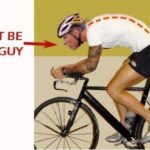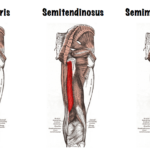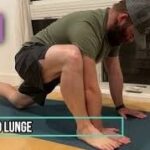Almost everybody has experienced back pain or tightness at one time or another. Limited flexibility, chronic aches and time lost from work are some of the consequences of this ailment. We strive to stay ahead of this disabling situation, but we are affected by it for a variety of reasons. They may include weak muscles, muscular imbalance, over-exertion and fatigue. Our posture, range of movement and even our moods are affected by these limitations. We will discuss the structure of the whole back muscles, both anatomically and functionally, though our focus will be on the mid and lower back. We will then provide a series of exercises for both strengthening and stretching the back muscles as a preventative measure for the future. These exercises are generally recommended, but please make sure to check with your physician before attempting them.
Structure
The back muscles are designed to direct various movements of the back (upper, mid and lower back), shoulders, neck and arms, provide protection of the spine and maintain an erect posture. They can be divided into three groups, based on their location and associated movements. The Superficial group is located along the mid to upper back and include the Latissimus Dorsi, Trapezius, Levator Scapulae and Rhomboids (Major and Minor). Their functions involve movements of the shoulders, scapula, arms and neck. They can be viewed in Figure 1. The Intermediate group includes the Serratus Posterior (Superior and Inferior). They are associated with the movements of the rib cage. The Deep group includes the Iliocostalis, Longissimus and Spinalis, collectively known as the Erector Spinae. They are the longest muscles in the back and run parallel and on each side of the spine (from the sacrum to the cervical portion of the vertebrae). The Spinalis lies medial to the Longissimus and the Iliocostalis is the most lateral of the three muscles. An illustration is provided in Figure 2. The function of the Erector Spinae is to extend, flex and laterally flex the vertebral column. Back pain tends to be located in the lower back region and these muscles need to be highlighted for strengthening and stretching purposes.
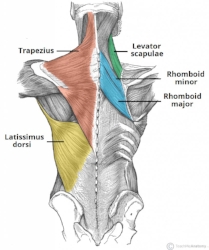
Fig. 1
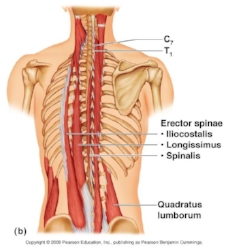
Fig. 2
Strengthening exercises
A series of two strengthening exercises provided below illustrates some easy weight lifting or core strengthening movements.
Reverse Fly
Stand tall with feet shoulder width apart, back straight with knees slightly bent. Hold a five to eight pound dumbbell in each hand, palms facing in and hinge forward at the waist. Bend elbows slightly and raise the weights out to the side, as far as you can. Return to starting position and repeat 2 sets of 16 reps. (Fig. 3)
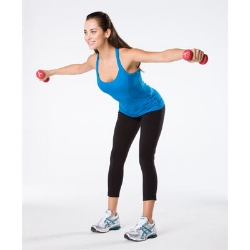
Fig. 3
Opposite Arm and Leg Reach
Start on your hands and knees. Reach your right hand forward while, at the same time stretching your left leg backward (and toes flexed). Hold for 5 seconds then release and repeat using the opposing arm and leg. Repeat this sequence 10 times. (Fig. 4)
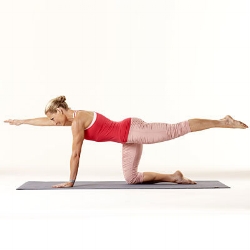
Fig. 4
Stretching exercises
Knee to Chest
Intended to stretch the lower back and glutes. Lie flat on your back and slowly bend your right knee, pulling your leg to your chest. Wrap your hands around your knee, holding that position for 20 seconds. Return your leg to the starting position and repeat the sequence for each leg. (Fig. 5)
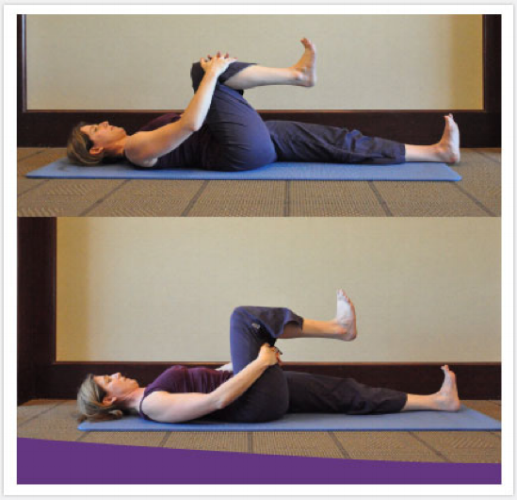
Fig. 5
Lumbar Traverse
This exercise is intended to stretch the Paraspinal muscles. Lie flat on your back with legs extended. Bend your right knee and cross it over the left side of your body. Hold that pose for 20 seconds and return to starting position. Repeat this sequence for each leg 3 times. (Fig. 6)

Fig. 6
Child’s Pose
This is a restful common pose in Yoga, meant to relax and decompress the lower back. Position yourself on the floor on your hands and knees, with knees splayed outward (wider than hip distance apart). Turn your feet inwards to touch and push your hips backward resting them on your heels. Extend your arms forward and allow your head to fall forward in a relaxed manner. Hold for 20 seconds and then return to starting position. Repeat this sequence 3 times. (Fig. 7)
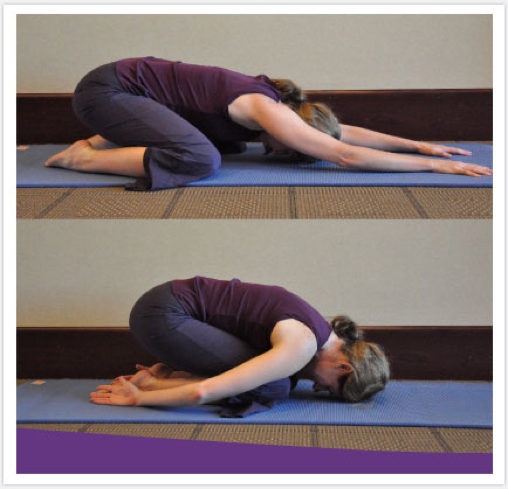
Fig. 7
A regular routine of strengthening and stretching of the lower back muscles can help avoid back injury or alleviate the pain when it occurs. It should not be a debilitating condition, though it is quite common. Massage is a valuable resource to help in relieving hypertonic muscles, decrease pain and discomfort and also increase range of motion. A massage session will often incorporate some of the stretches listed above, if applicable for your needs. A massage therapist can assist you, to supplement the measures you may have already undertaken.
References:
- Fig. 1: http://teachmeanatomy.info/back/muscles/superficial/ (viewed 4/3/17)
- Fig. 2: https://www.pinterest.com/pin/343047696587939838/ (viewed 4/3/17)
- Fig. 3: http://www.health.com/health/gallery/0,,20709957,00.html#reverse-fly-0 (viewed 4/12/17)
- Fig. 4: http://www.health.com/health/gallery/0,,20709957,00.html#opposite-arm-and-leg-reach-0 (viewed 4/12/17)
- Fig. 5, 6 & 7: http://www.apmhealth.com/education/healthy-living/stretching—strengthening-tips/6-stretches-to-help-back-pain (viewed 4/12/17)
- http://teachmeanatomy.info/back/muscles/intrinsic/ (viewed 4/3/17)
- http://anatomy.uams.edu/introback.html (viewed 4/12/17)
- http://www.mayoclinic.org/diseases-conditions/back-pain/basics/prevention/con-20020797 (viewed 4/12/17)
- http://anatomyzone.com/tutorials/musculoskeletal/extrinsic-muscles-of-the-back/ (viewed 4/12/17)
- http://www.kingofthegym.com/back-anatomy (viewed 4/3/17)
- http://www.spine-health.com/wellness/exercise/stretching-back-pain-relief (viewed 4/12/17)
- http://www.sport-fitness-advisor.com/muscular-system-diagram.html (viewed 4/12/17)
This article/video is for educational purposes only; do not attempt without your physician’s clearance. If you are in pain or injured, see your physician.
Copyright © Vidal Sports LLC 2018





